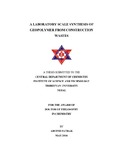Please use this identifier to cite or link to this item:
http://archive.nnl.gov.np:8080/handle/123456789/335Full metadata record
| DC Field | Value | Language |
|---|---|---|
| dc.contributor.author | PATHAK, ARVIND | |
| dc.date.accessioned | 2019-03-24T07:18:48Z | |
| dc.date.accessioned | 2020-08-21T07:33:26Z | - |
| dc.date.available | 2019-03-24T07:18:48Z | |
| dc.date.available | 2020-08-21T07:33:26Z | - |
| dc.date.issued | 2019-03-24 | |
| dc.identifier.uri | http://103.69.125.248:8080/xmlui/handle/123456789/335 | - |
| dc.description.abstract | In the 21st century global warming becoming the most challenging problem, a huge amount of wastes are generated due to the rapid urbanization and construction of several new structures, renovation and demolition of old buildings especially in developing countries several million tons of construction and demolition wastes (CDW) globally. Much of the concrete waste from the construction industries is used as land filled, leading to environmental and ecological problems such as occupation of large areas of land, generation of dust, contamination of surface and underground water. | en_US |
| dc.language.iso | en | en_US |
| dc.subject | Alkaline activator; Compressive strength; Construction and demolition waste; Geopolymerisation; Global warming. | en_US |
| dc.title | FOR THE AWARD OF DOCTOR OF PHILOSOPHY IN CHEMISTRY | en_US |
| dc.type | Thesis | en_US |
| Appears in Collections: | 500 Natural sciences and mathematics | |
Files in This Item:
| File | Description | Size | Format | |
|---|---|---|---|---|
| 1_Arvind Pathak_PhD Thesis.pdf | 5.22 MB | Adobe PDF |  View/Open |
Items in DSpace are protected by copyright, with all rights reserved, unless otherwise indicated.